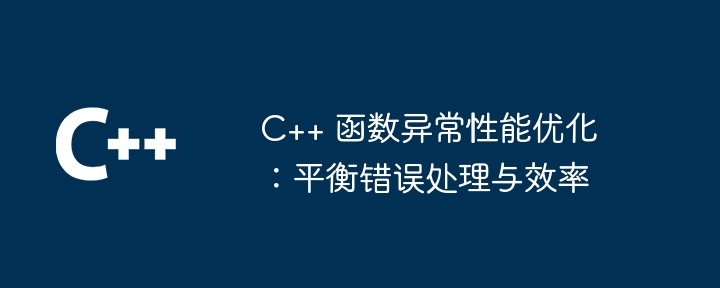異常處理最佳化可平衡錯誤處理與效率:僅在嚴重錯誤時使用異常。使用 noexcept 規範聲明不引發異常的函數。避免巢狀異常,將其放入 try-catch 區塊中。使用 exception_ptr 捕獲不能立即處理的異常。

C 函數異常效能最佳化:平衡錯誤處理與效率
簡介
#在C 中使用異常處理對於處理錯誤條件至關重要。然而,濫用異常可能會對效能產生重大影響。本文將探討優化異常處理以平衡錯誤處理和效率的技巧。
最佳化原則
實戰案例
未經最佳化的程式碼:
void process_file(const std::string& filename) {
try {
std::ifstream file(filename);
// 代码过程...
} catch (std::ifstream::failure& e) {
std::cerr << "Error opening file: " << e.what() << std::endl;
}
}使用nofail:
void process_file_nofail(const std::string& filename) {
std::ifstream file(filename, std::ifstream::nofail);
if (!file) {
std::cerr << "Error opening file: " << file.rdstate() << std::endl;
return;
}
// 代码过程...
}使用try-catch 區塊:
void process_file_try_catch(const std::string& filename) {
std::ifstream file(filename);
try {
if (!file) {
throw std::runtime_error("Error opening file");
}
// 代码过程...
} catch (const std::runtime_error& e) {
std::cerr << "Error: " << e.what() << std::endl;
}
}使用exception_ptr:
std::exception_ptr process_file_exception_ptr(const std::string& filename) {
std::ifstream file(filename);
try {
if (!file) {
throw std::runtime_error("Error opening file");
}
// 代码过程...
} catch (const std::runtime_error& e) {
return std::make_exception_ptr(e);
}
return nullptr;
}以上是C++ 函數異常效能最佳化:平衡錯誤處理與效率的詳細內容。更多資訊請關注PHP中文網其他相關文章!




